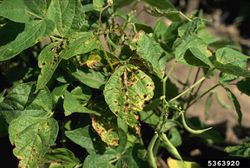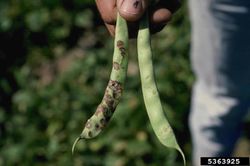Pseudomonas syringae pv. syringae
| Literature database |
|---|
| 306 articles sorted by: |
| • year (descending) |
| • research topics |
| • countries/regions |
| • host plants |
| • list of antagonists |

Author(s): Howard F. Schwartz, Colorado State University
Source: IPM Images
Pseudomonas syringae pv. syringae van Hall 1902
The pathovar causes bacterial blight and canker on Phaseolus bean, stone fruits, pear (blast), persimmon and other crops. The pathogen is widespread in temperate and subtropical regions. The symptoms vary with the host plant. On stone fruits, mainly the stems and branches become infected which can lead to tree death. The bacteria might overwinter epiphytically on buds or in stem cankers and cause blossom blast in spring. It then spreads to branches or stems and enters these through small wounds. Freezing temperatures increase the severity of the disease. Management is difficult. Copper sprays are the standard approach against bacterial diseases, but only work when the pathogen is on the surface. Some limited progress has been made on developing resistant cultivars.

Author(s): Howard F. Schwartz, Colorado State University
Source: IPM Images
| Vernacular names | |
|---|---|
| • Deutsch: | Bakterienbrand des Zitrus Bakterienbrand des Steinobsts Fliederseuche |
| • English: | blast of citrus brown spot disease of beans citrus blast blast of pear |
| • Español: | chancro bacteriano del ciruelo |
| • Français: | bactériose des arbres fruitiers à noyau taches bactériennes du haricot |
The page Pseudomonas syringae gives a general overview of the biology of this bacterium.